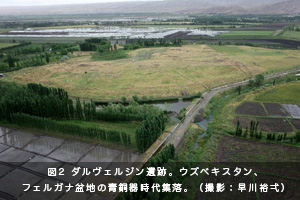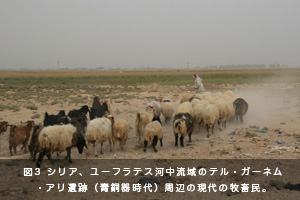久米 正吾(くめ しょうご)
私は西アジアと中央アジアを調査地として、新石器時代から青銅器時代にかけて成立・展開する農耕牧畜社会の地理的多様性を考古学的に調べています。現在は、中央アジアのキルギスとウズベキスタンの山岳・山麓地帯に位置する遺跡で発掘調査を実施し、遊牧国家という中央ユーラシア地域を歴史的に特徴づける政治組織の基層が形成された背景について、環境への適応あるいは人や文化の移動と交流の観点から明らかにすることを目指しています。
2008年から2011年にかけては、本プロジェクトの課題とも密接に関連する西アジアのシリア、ユーフラテス河中流域のステップ地帯に位置する青銅器時代墓地遺跡の発掘調査に加わり、祖先を通じた遊牧部族社会の統合原理を物的証拠に則して示す試みもおこなってきました。
本プロジェクトではこうした経験を踏まえ、ヨルダンやサウジアラビアの内陸砂漠地帯という異なる環境での牧畜社会に関する理解を深めることによって、新石器時代以降のユーラシア大陸各地に生まれた食糧生産社会の発展過程の多様なあり方について考察したいと考えています。
主な著書・論文
・久米正吾、アイダ・アブディカノワ「キルギス、天山山中の移牧民遺跡の考古学調査2」(2021)今村薫(編)『中央アジア牧畜社会研究叢書2 遊牧と定住化』93-102頁、科学研究費補助金報告書。
・Kume, S., Y. Miyata and S. Kadowaki (2017) “Feasting with the dead on the Euphrates: Stable isotope analysis of carbonized residues on Early Bronze Age ceramics from the cemetery near Tell Ghanem al-‘Ali.” Al-Rafidan 38 (Special Volume: Papers in honor of Professor Katsuhiko Ohnuma on the occasion of his 70th birthday): 95-100.
・Kume, S. and A. Sultan (2014) “Burials, nomads, and cities: A perspective to changing nomad-sedentary relations on the Syrian Middle Euphrates during the third and second millennium BC.” In: D. Morandi Bonacossi (ed.), Settlement Dynamics and Human-Landscape Interaction in the Dry Steppes of Syria. pp. 137-150. Wiesbaden: Harrassowitz Verlag.
・Kume, S. (2013) “Gypsum plaster manufacturing in northeast Syria: An ethnographic case study.” In: Y. Nishiaki, K. Kashima and M. Verhoeven (eds.), Neolithic archaeology in the Khabur Valley, Upper Mesopotamia and beyond. pp.80-95. Berlin: ex oriente.
・Numoto, H. and S. Kume (2010) “Survey and sondage at the cemeteries near the site of Tell Ghanem al-’Ali.” In K. Ohnuma et al. (eds.), Al-Rafidan special issue. Formation of tribal communities: Integrated research in the Middle Euphrates, Syria. pp. 49-60. Tokyo: The Institute for Cultural Studies of Ancient Iraq, Kokushikan University.











